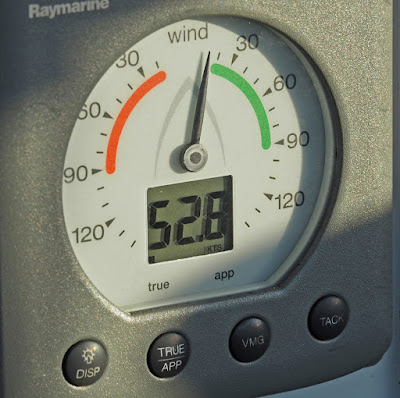Twelve years ago we purchased a set of plaited nylon dock lines for Crystal Blues, made by Marlow in England.
These were an expensive purchase back then, but we wanted the nylon for it's natural stretch - what a great shock absorber nylon is.
We purchased plaited nylon lines because they are quieter than double braid - they do not creak and squeak when cyclic pressure is applied at fair-leads and cleats. This
silent behaviour is important to live-aboard cruisers, or at least to those who wish to sleep at night.
However we know that nylon is degraded by UV light, and in recent years we've been careful to add additional dock lines whenever the wind strength increased.
Here in South Africa the winds have been incredibly strong, and we were keen to replace the old lines as soon as possible. We looked at a range of locally made plaited lines made from nylon or polyester, and also at double braid lines that use a nylon core protected by a braided polyester cover.
 |
| Markus Loading The Test Machine |
However, before spending our hard earned cash, we decided to see just how strong our existing dock lines were - could they still be trusted? We visited the
Southern Ropes factory in Cape Town, where we were able to
destructively test one of our existing dock lines. The results were, quite frankly,
very disturbing.
With great assistance from Markus Progli at Southern Ropes our very tired dock line sample was tied to the test cell.
Markus set the test in motion and then stood back a little from the machine, with fingers planted in each ear. What was going on we asked? Markus walked even further from the machine and then explained that when the line broke the noise would be incredibly loud - loud enough for people even in adjacent factory buildings to hear it!
At his suggestion we moved further from the machine, hands over ears, waiting for the big bang. At this point the line was stretching incredibly, having increased in length over 50%. Small creaking noises could be heard, high pitched squeaks and squeals from the tortured line.
Lines That Go Bang When They Break
 |
| Starting The Test |
So what happened next? At 100% stretch (the sample had doubled in length) the nylon line finally broke, not with a bang, but with a
pitiful UV degraded whimper!
The test rig showed the failure at 749kg, which is rather poor when we consider the original 16mm line had a rated breaking strain of 6,640kg. The nylon line had lost more than 85% of it's original
strength.
It was completely rotten, due to UV degradation.
 |
| Use The 16mm Dockline Or The 2mm Dynema String ? |
At this stage of the test I was surprised to see Markus with a cheeky twinkle in his eye. He looked around among the various rope samples in the test area and appeared triumphantly with a
very thin piece of Southern Ropes Dynema line.
Handing Ley a piece of
2mm diameter Dynema "string", he said "hey, you should tie your boat up
with this, it's actually stronger than your dock lines"! OK, so he made his point, though Dynema doesn't stretch enough to be useful as a dock line.
 |
| Goodbye Old Friends |
Now we know that our old nylon dock lines are
well past their use by date.
So we're evaluating replacements, and leaning towards double braid lines that use a nylon core with a woven polyester cover to eliminate the UV damage. The cover is very loose on the core, and should not squeak (we hope).
We've purchased two for testing, and they have remained silent even in Cape Town's high winds and mobile marinas. These should last for many years without such a dramatic loss of strength.
Can anyone comment on the mixed nylon / polyester lines ? Do they squeak and squeal ?


 Note the "W"
as the final letter in the model number - that signifies "weather
proof", implying UV stabilised. You can buy a similar product without
that "W" notation, but it will not last as long...
Note the "W"
as the final letter in the model number - that signifies "weather
proof", implying UV stabilised. You can buy a similar product without
that "W" notation, but it will not last as long...

























